Influence of Non-Constant Hygrothermal Parameters on Heat and Moisture Transfer in Rammed Earth Walls
Abstract
:1. Introduction
2. Testing of Hygrothermal Parameters of Earth Materials
2.1. Thermal Conductivity
2.1.1. Specimen Preparation
2.1.2. Thermal Conductivity Test
2.1.3. Results
2.2. Water Vapor Permeability
2.2.1. Experimental Principle
2.2.2. Water Vapor Permeability Test
2.2.3. Results
3. Mathematical Model
3.1. Heat and Moisture Transfer Equations in the Rammed Earth Wall
3.1.1. Moisture Transfer Equation
3.1.2. Heat Transfer Equation
3.1.3. Boundary Conditions
3.2. Heat and Moisture Equilibrium Equation of Indoor Air in a Rammed Earth Building
3.2.1. Heat Equilibrium Equation of Indoor Air
3.2.2. Moisture Equilibrium Equation of Indoor Air
3.3. Model Validation
4. Simulation of Heat and Moisture Transfer
4.1. Steady Boundary
4.2. Period Boundary
4.3. Mianyang Climate Boundary
5. Conclusions
- The thermal conductivity of the earth materials from Northwest Sichuan is linearly related to moisture content, with R2 being greater than 0.98. The water vapor permeability has a small variation in the 0–60% relative humidity range and increases exponentially above 60%.
- A numerical model with temperature and humidity as driving potential was established. The measured data of the rammed earth building are in good agreement with the simulation results under the same conditions.
- At a steady boundary, when the moisture content of the rammed earth wall was low, the thermal conductivity and water vapor permeability under the constant condition were higher than that under the function condition, making the temperature and the heat flux on the internal surface of the wall under the constant condition greater. Among them, the average relative error of internal surface temperature was 0.93%, which is small. The average relative error of heat flux and latent heat flux was 8.42% and 6.07%, respectively, which shows a large difference.
- Under the periodic boundary, the internal surface temperature of the rammed earth wall shows a small difference between the two conditions. The average temperature difference of the internal surface was less than 0.1 °C in wet and dry conditions in summer. The heat flux on the internal surface under constant conditions was 4.65% higher than that under functional conditions, and the latent heat flux on the internal surface under constant conditions was 9.93% higher than that under function conditions in the humid summer condition. In the dry summer conditions, the figures were 2.02% and −0.30%. The heat transfer difference between the two conditions is more obvious in high temperature and high humidity conditions.
- Under the climate boundary of Mianyang City, the rammed earth building indoor air temperature and humidity in summer and winter were similar under the two conditions. The largest difference in heat transfer on the internal surface was in summer, and under constant conditions was 7.52% higher than that under functional conditions. Meanwhile, the largest difference in latent heat transfer on the internal surface was in spring, and under constant conditions was 6.11% higher than that under functional conditions. Throughout the whole year, the heat flux under constant conditions was 4.97% higher than that under functional conditions, and the latent heat flux under constant conditions was 5.03% higher than that under functional conditions. There is a significant difference in heat transfer between the two conditions in hot and humid areas.
Author Contributions
Funding
Institutional Review Board Statement
Informed Consent Statement
Data Availability Statement
Conflicts of Interest
Nomenclature
| moisture content (kg/m3) | |
| density of moisture flux (kg/m2s) | |
| thickness of specimen (m) | |
| mass of specimen (kg) | |
| superficial area of the specimen (m2) | |
| radius of the specimen (m) | |
| temperature (K) | |
| liquid water permeability (s) | |
| partial water vapor pressure (Pa) | |
| partial pressure of saturated vapor (Pa) | |
| gas constant of water vapor (J/kgK) | |
| specific heat capacity of dry material (J/kgK) | |
| specific heat capacity of liquid water (J/kgK) | |
| specific heat capacity of air (J/kgK) | |
| latent heat of water phase change (J/kg) | |
| moisture flux through the internal surface (kg/m2s) | |
| moisture flux through the external surface (kg/m2s) | |
| heat flux through the internal surface (W) | |
| heat flux through the external surface (W) | |
| convective heat transfer coefficient (W/m2K) | |
| convective heat transfer coefficient of internal surface (W/m2K) | |
| convective heat transfer coefficient of external surface (W/m2K) | |
| indoor partial pressure of saturated vapor (Pa) | |
| outdoor partial pressure of saturated vapor (Pa) | |
| partial pressure of saturated vapor on the internal surface (Pa) | |
| partial pressure of saturated vapor on the external surface (Pa) | |
| indoor temperature (K) | |
| outdoor temperature (K) | |
| the temperature on the internal surface (K) | |
| the temperature on the external surface (K) | |
| solar radiation (W/m2) | |
| volume of structure (m3) | |
| heat transfer (J/m2) | |
| goodness of fit | |
| Greek symbols | |
| solar absorptivity of the external surface | |
| density of air (kg/m3) | |
| density of liquid water (kg/m3) | |
| density of building materials (kg/m3) | |
| water vapor permeability (kg/m·s·Pa) | |
| sorption capacity (kg/m3) | |
| thermal conductivity (W/mK) | |
| moisture exchange transfer coefficient (m/s) | |
| moisture exchange transfer coefficient of internal surface (m/s) | |
| moisture exchange transfer coefficient of external surface (m/s) | |
| relative humidity (%) | |
| indoor relative humidity (%) | |
| outdoor relative humidity (%) | |
| relative humidity of internal surface (%) | |
| relative humidity of external surface (%) |
References
- Guo, Y.-Y. Revisiting the building energy consumption in China: Insights from a large-scale national survey. Energy Sustain. Dev. 2022, 68, 76–93. [Google Scholar] [CrossRef]
- Ness, D.A.; Xing, K. Toward a Resource-Efficient Built Environment: A Literature Review and Conceptual Model. J. Ind. Ecol. 2017, 21, 572–592. [Google Scholar] [CrossRef]
- Cagnon, H.; Aubert, J.E.; Coutand, M.; Magniont, C. Hygrothermal properties of earth bricks. Energy Build. 2014, 80, 208–217. [Google Scholar] [CrossRef]
- Touré, P.; Sambou, V.; Faye, M.; Thiam, A.; Adj, M.; Azilinon, D. Mechanical and hygrothermal properties of compressed stabilized earth bricks (CSEB). J. Build. Eng. 2017, 13, 266–271. [Google Scholar] [CrossRef]
- Brambilla, A.; Jusselme, T. Preventing overheating in offices through thermal inertial properties of compressed earth bricks: A study on a real scale prototype. Energy Build. 2017, 156, 281–292. [Google Scholar] [CrossRef]
- Liuzzi, S.; Hall, M.R.; Stefanizzi, P.; Casey, S.P. Hygrothermal behaviour and relative humidity buffering of unfired and hydrated lime-stabilised clay composites in a Mediterranean climate. Build. Environ. 2013, 61, 82–92. [Google Scholar] [CrossRef]
- Hall, M.; Allinson, D. Analysis of the hygrothermal functional properties of stabilised rammed earth materials. Build. Environ. 2009, 44, 1935–1942. [Google Scholar] [CrossRef] [Green Version]
- Sabbà, M.F.; Tesoro, M.; Falcicchio, C.; Foti, D. Rammed Earth with Straw Fibers and Earth Mortar: Mix Design and Mechanical Characteristics Determination. Fibers 2021, 9, 30. [Google Scholar] [CrossRef]
- Yi, H. Rapid thermal conductivity measurement with a hot disk sensor. Thermochim. Acta 2005, 436, 122–129. [Google Scholar]
- Nikiforova, T.; Savytskyi, M.; Limam, K.; Bosschaerts, W.; Belarbi, R. Methods and Results of Experimental Researches of Thermal Conductivity of Soils. Energy Procedia 2013, 42, 775–783. [Google Scholar] [CrossRef] [Green Version]
- Huangfu, H.; Jin, H. Experimental study of the effect of moisture content on the thermal conductivity of earth commonly used in engineering. Water Resour. Power 2015, 33, 122–124. [Google Scholar]
- Zheng, Q.; Jin, H.; Liu, H.; Zhang, C.; Niu, K. Effect of porosity and water content on the thermal conductivity of sandy earth samples. Water Resour. Power 2015, 33, 125–128. [Google Scholar]
- Mukhopadhyaya, P.; Kumaran, M.K.; Lackey, J. Use of the modified cup method to determine temperature dependency of water vapor transmission properties of building materials. J. Test. Eval. 2005, 33, 316–322. [Google Scholar]
- Li, K.; Zhang, X.; Han, X.; Zhu, D. Experimental study of the water vapour permeability of building materials. J. Build. Mater. 2009, 12, 284–287. [Google Scholar]
- Bai, W. Structural Renewal of Dwellings and Sustainable Use of Natural Building Materials in Yunnan; Tsinghua University: Beijing, China, 2009. [Google Scholar]
- Korjenic; Sinan; Ashour; Taha; Wei; Azra. Thermal conductivity of unfired earth bricks reinforced by agricultural wastes with cement and gypsum. Energy Build. 2015, 104, 139–146. [Google Scholar] [CrossRef]
- Mansour, M.B.; Jelidi, A.; Cherif, A.S.; Jabrallah, S.B. Optimizing thermal and mechanical performance of compressed earth blocks (CEB). Constr. Build. Mater. 2016, 104, 44–51. [Google Scholar] [CrossRef]
- Giada, G.; Caponetto, R.; Nocera, F. Hygrothermal Properties of Raw Earth Materials: A Literature Review. Sustainability 2019, 11, 5342. [Google Scholar] [CrossRef] [Green Version]
- Chu, S.S.; Fang, T.H.; Chang, W.J. Modelling of coupled heat and moisture transfer in porous construction materials. Math. Comput. Model. 2009, 50, 1195–1204. [Google Scholar] [CrossRef]
- Santos, G.; Mendes, N. Heat, air and moisture transfer through hollow porous blocks. Int. J. Heat Mass. Transf. 2009, 52, 2390–2398. [Google Scholar] [CrossRef]
- Chow, T.T.; Fong, K.F.; Givoni, B.; Lin, Z.; Chan, A. Thermal sensation of Hong Kong people with increased air speed, temperature and humidity in air-conditioned environment. Build. Environ. 2010, 45, 2177–2183. [Google Scholar] [CrossRef]
- Pei, Q.Q.; Chen, Z.K. An Experimental Study on Isothermal Moisture Absorption and Desorption Processes of Some Common used Building Materials. J. Hunan Univ. 1999, 26, 96–99. [Google Scholar]
- van Schijndel, A.W.M. Multiphysics modeling of building physical constructions. Build. Simul. 2011, 4, 49–60. [Google Scholar] [CrossRef]
- Liu, D.; Zhao, H.; Liu, X.; He, Q. Testing the thermal conductivity of earth at different moisture contents and the effect on building energy consumption. J. Civ. Environ. Eng. 2017, 39, 20–25. [Google Scholar]
- SL237-1999; Specification of Soil Test. Institute, N.H.R.: Beijing, China, 1999.
- Shang, J. Optimisation of Ecological Building Material Systems for Traditional Rammed Earth Dwellings. Ph.D. Thesis, Xi’an University of Architecture and Technology, Xi’an, China, 2005. [Google Scholar]
- BS EN ISO 12572; Hygrothermal Performance of Building Materials and Products—Determination of Water Vapour Transmission Properties—Cup Method. British Standards Institution: London, UK, 2016.
- Dean, J.A. Lange’s Handbook of Chemistry, 15th ed.; McGraw-Hill, Inc.: St. Louis, MO, USA, 1999. [Google Scholar]
- Galbraith, G.H.; McLean, R.C.; Guo, J. Moisture permeability data: Mathematical presentation. Build. Serv. Eng. Res. Technol. 1998, 19, 31–36. [Google Scholar] [CrossRef]
- Liang, J.; Tan, J.; Jiang, B. Thermal and humid environment of rammed-earth dwellings in Northwest Sichuan. Indoor Built Environ. 2022, 31, 645–656. [Google Scholar] [CrossRef]
- Bear, J. Modelling Transport Phenomena in Porous Media. In Convective Heat and Mass Transfer in Porous Media; Kakaç, S., Kilkiş, B., Kulacki, F.A., Arinç, F., Eds.; Springer Netherlands: Dordrecht, The Netherlands, 1991; pp. 7–69. [Google Scholar]
- Kast, D.; Jokisch, F. Considerations regarding the development of sorption isotherms and the sorption kinetics in porous solids. Chem. Ing. Technol. 1972, 44, 556–563. [Google Scholar] [CrossRef]
- Liu, X.; Chen, Y.; Ge, H.; Fazio, P.; Chen, G. Numerical investigation for thermal performance of exterior walls of residential buildings with moisture transfer in hot summer and cold winter zone of China. Energy Build. 2015, 93, 259–268. [Google Scholar] [CrossRef]
- Liu, Y.; Wang, Y.; Wang, D.; Liu, J. Effect of moisture transfer on internal surface temperature. Energy Build. 2013, 60, 83–91. [Google Scholar] [CrossRef]
- Yan, Z. Study of Indoor Heat and Moisture Environments in Rammed Earth Buildings; Xi’an University of Architecture and Technology: Xi’an, China, 2003. [Google Scholar]
- Wang, L. Study of Thermal Processes in Envelope Structures under the Effect of Periodic Double Fluctuations; Xi’an University of Architecture and Technology: Xi’an, China, 2010. [Google Scholar]


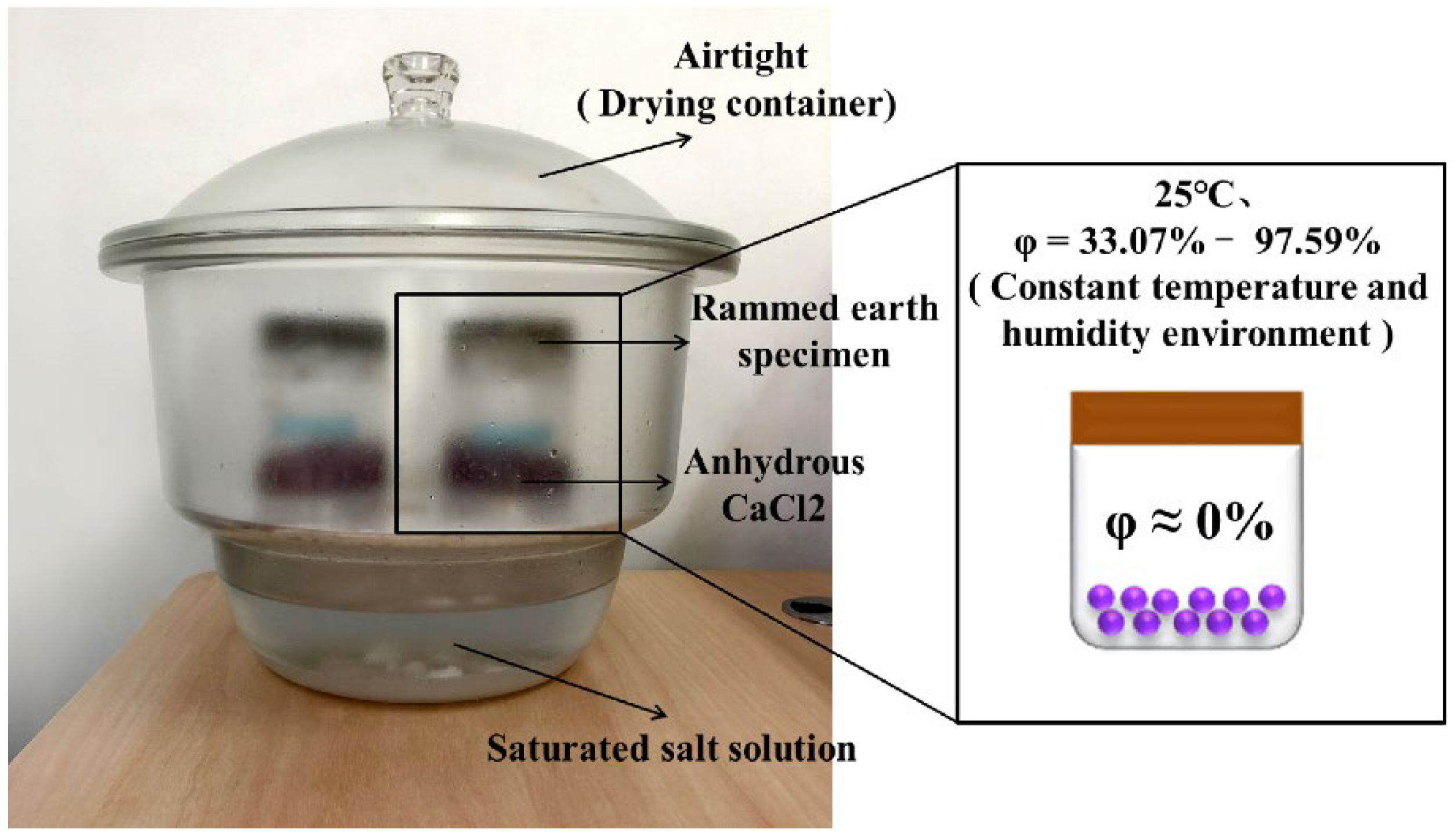
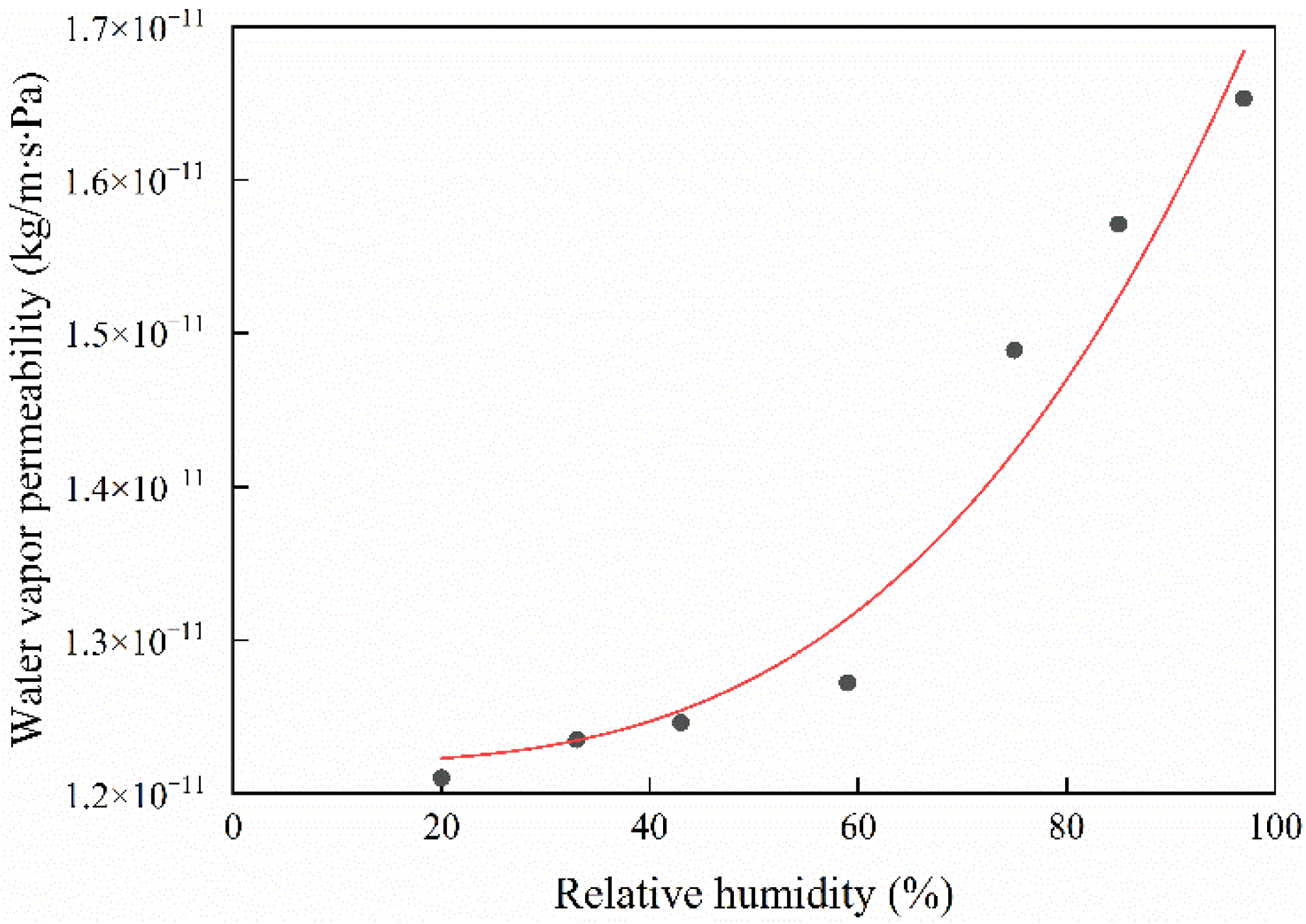
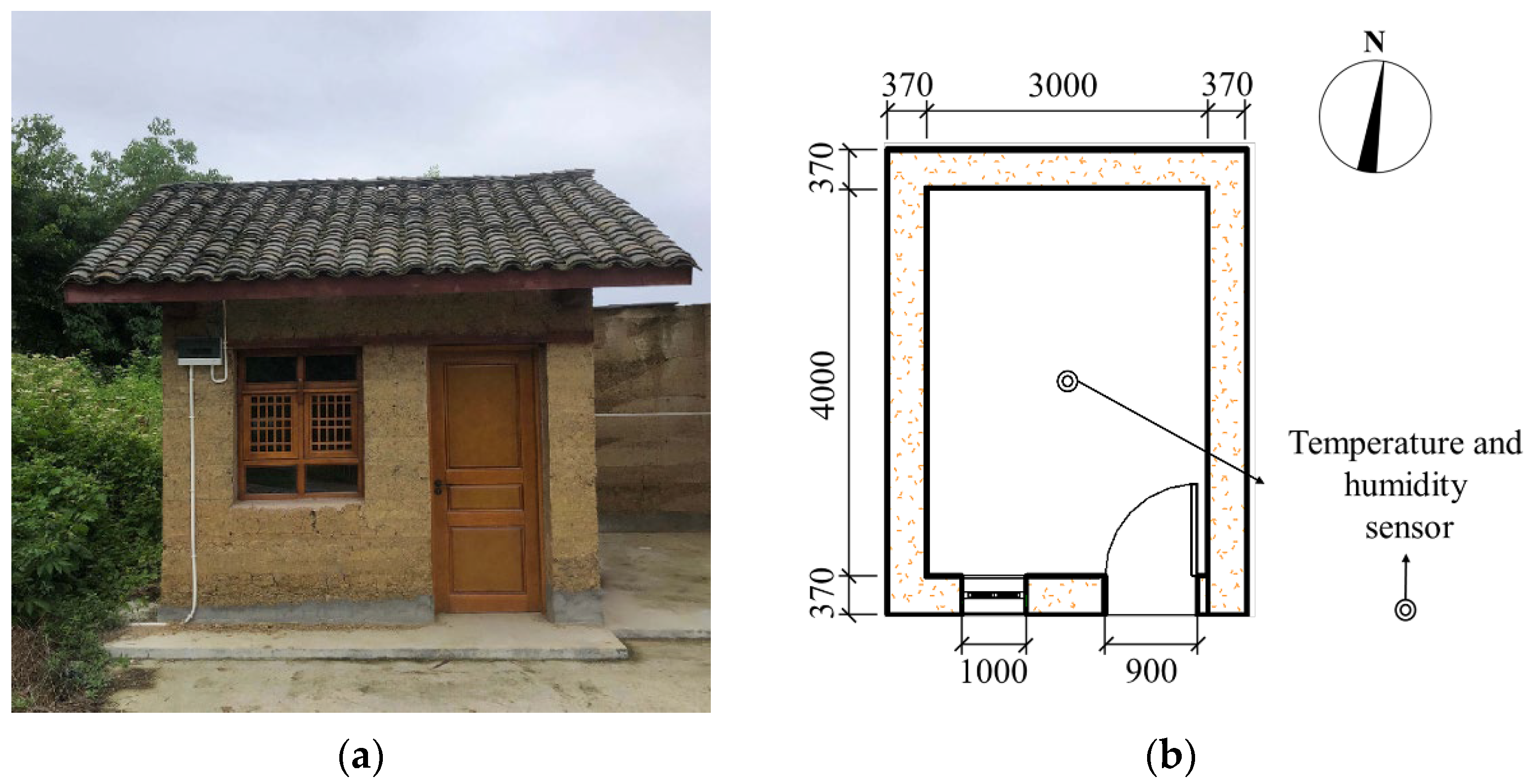
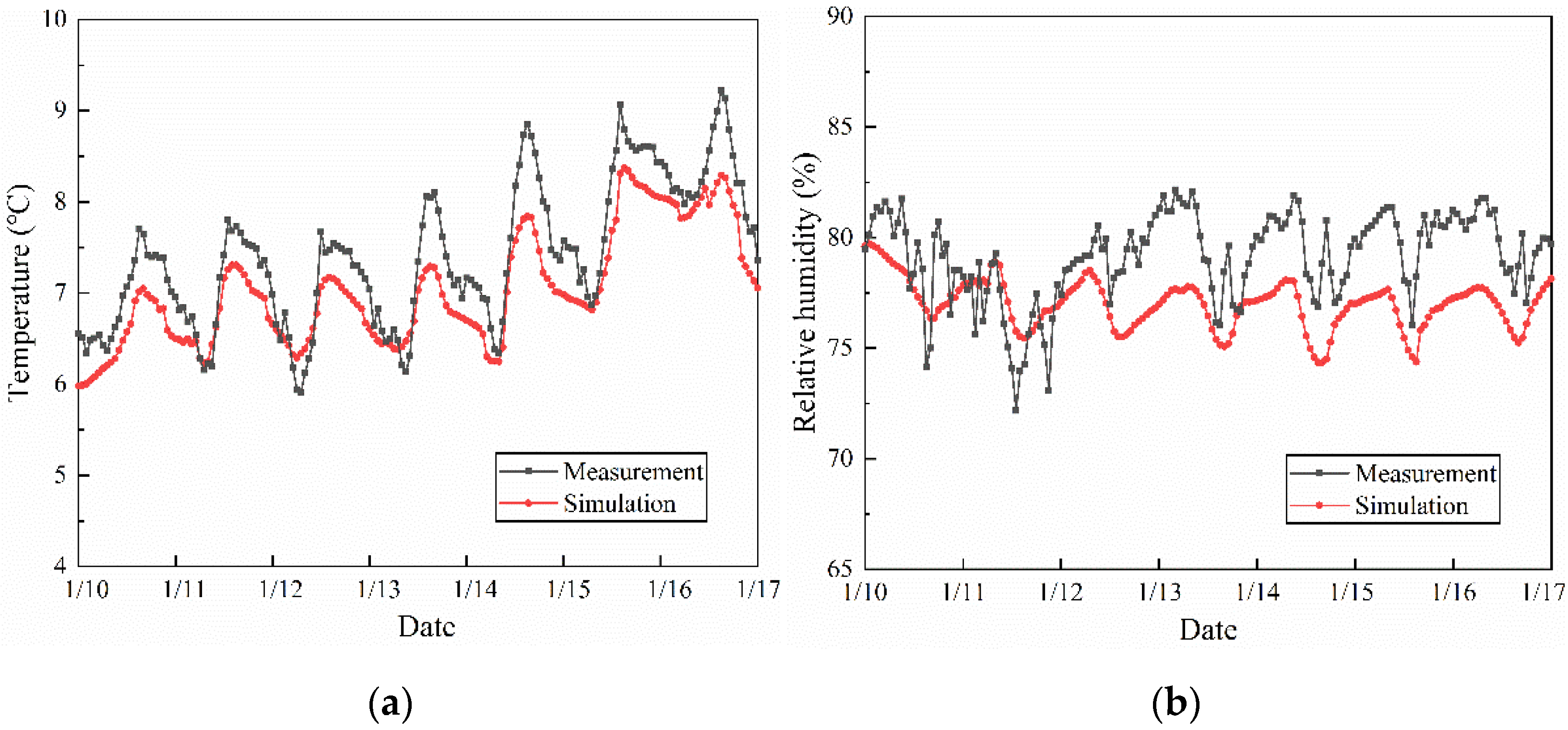
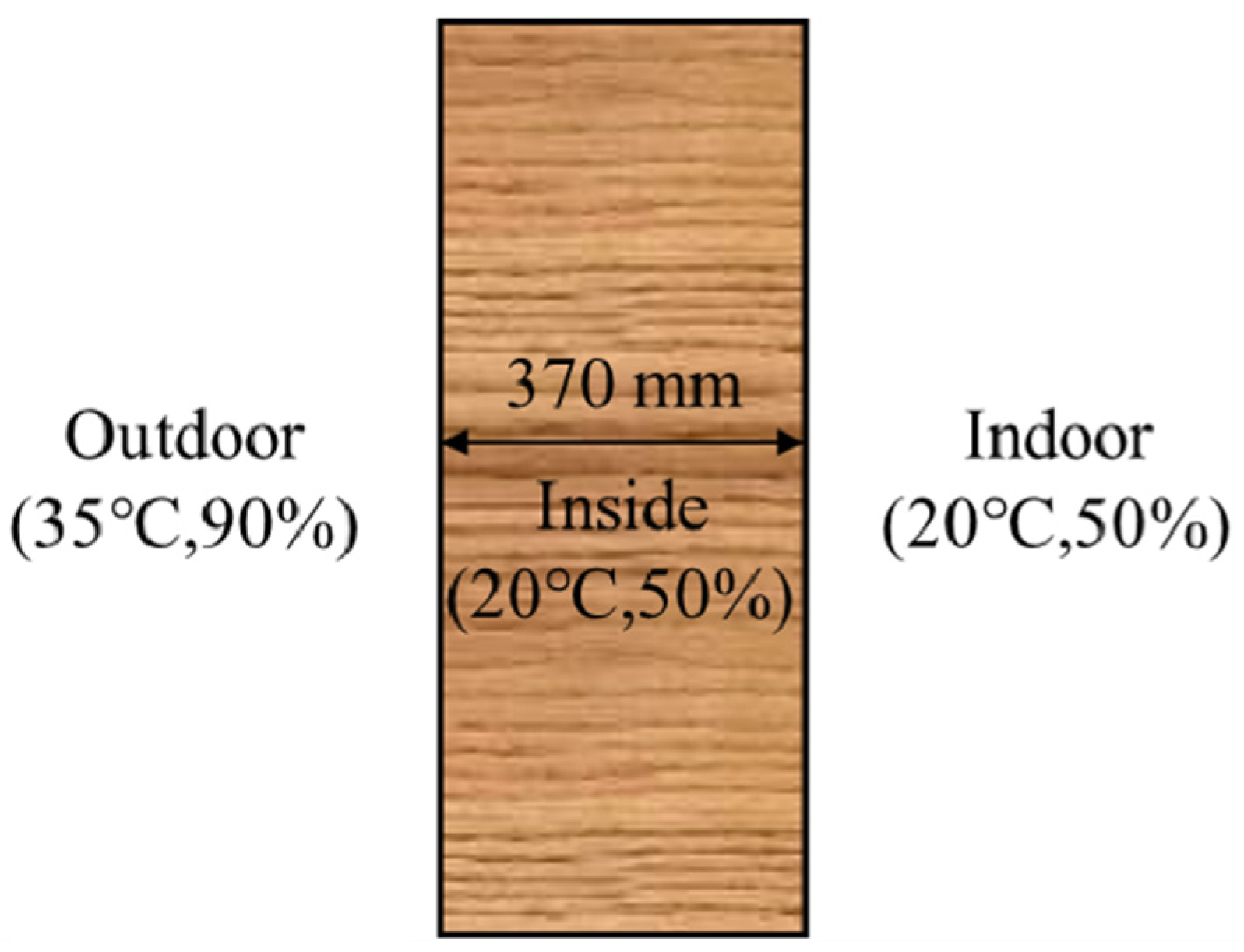

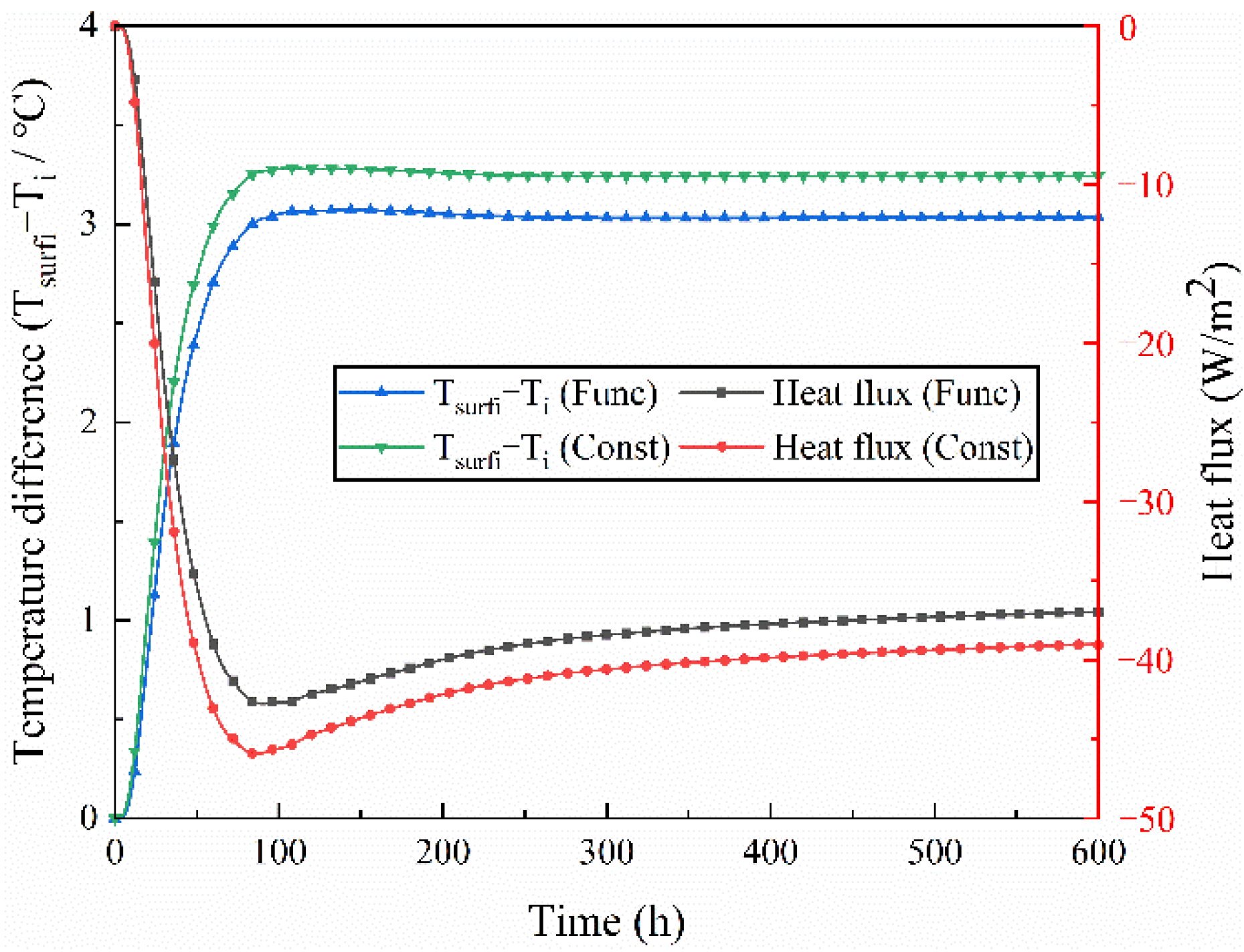
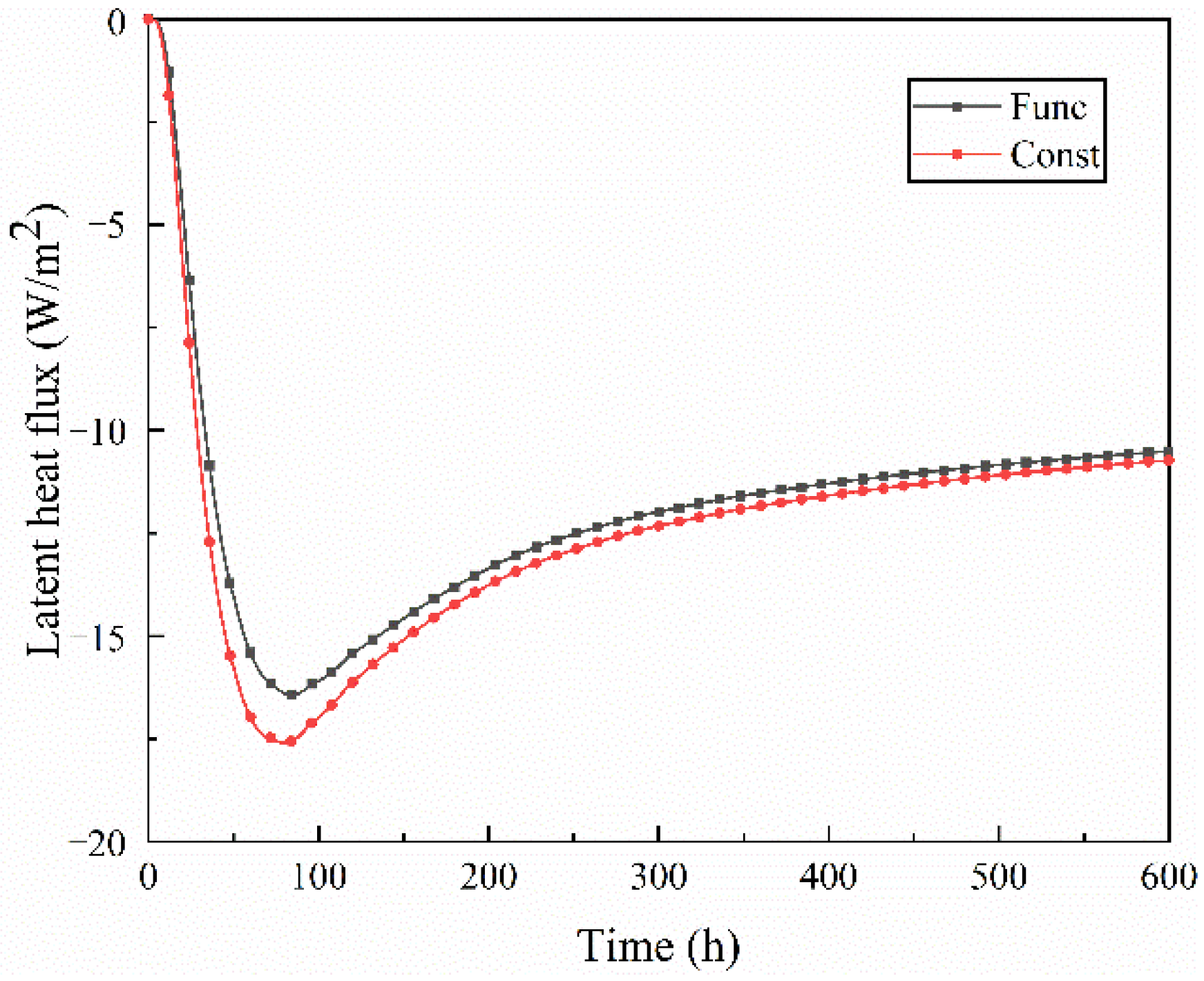
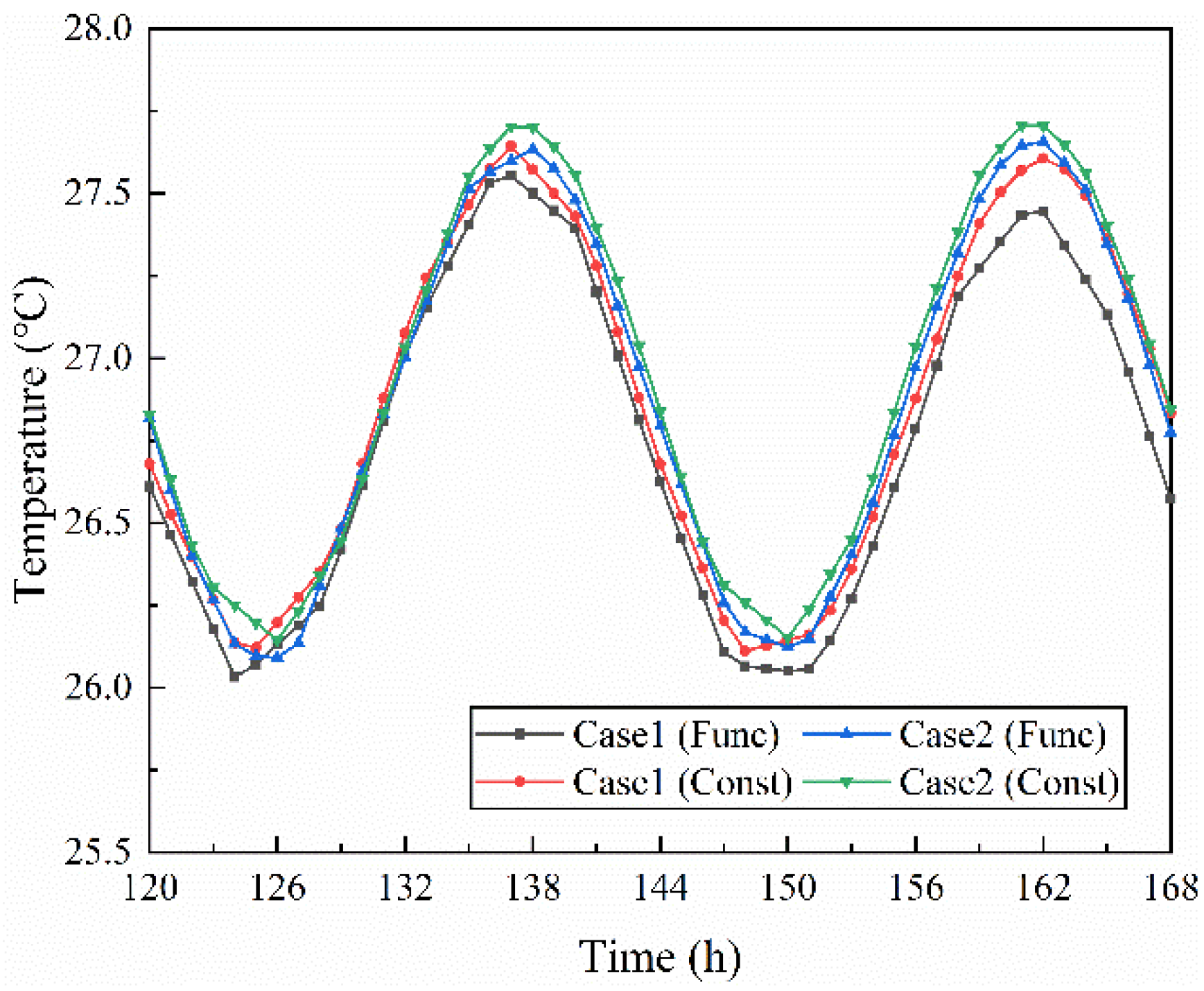
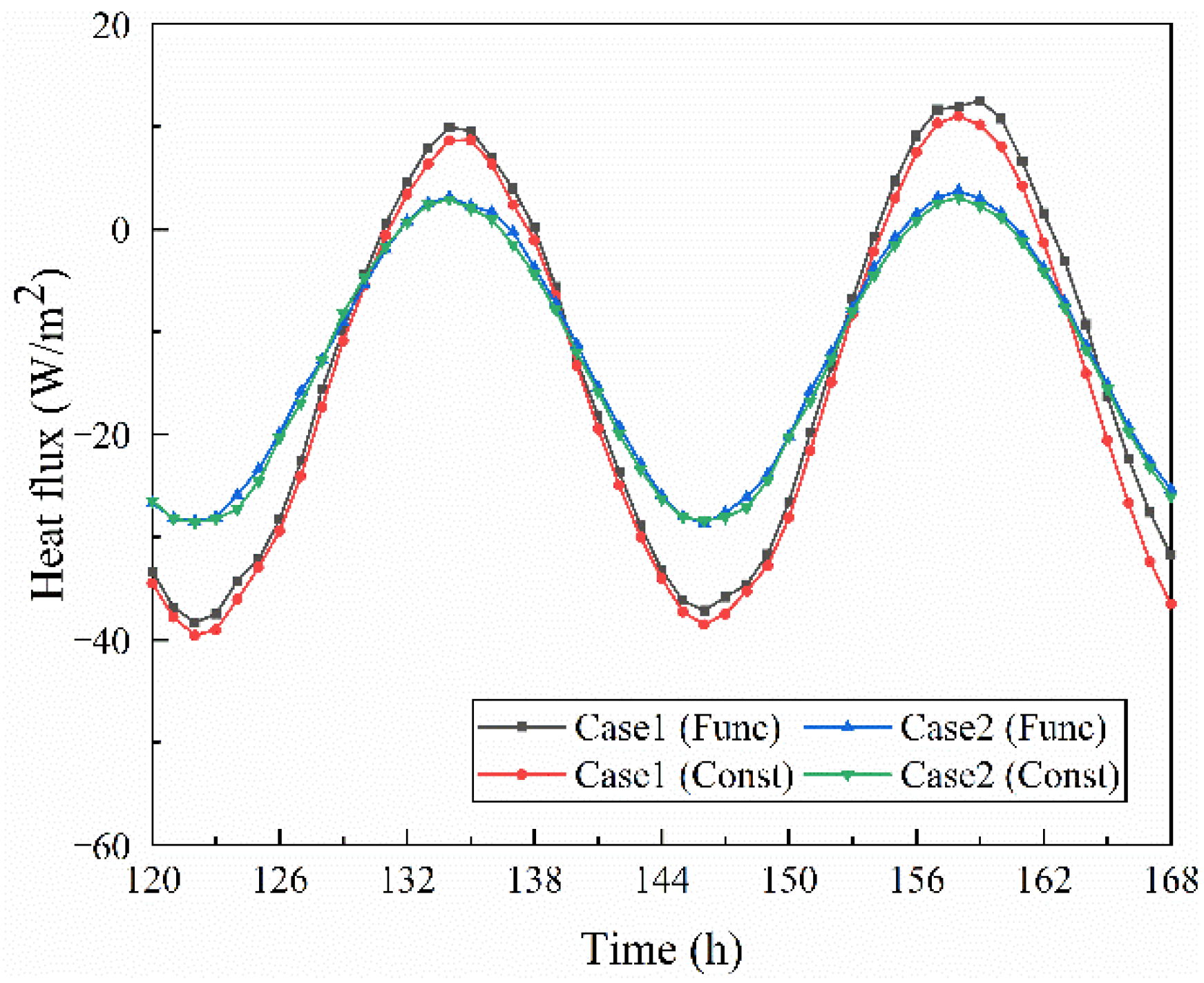
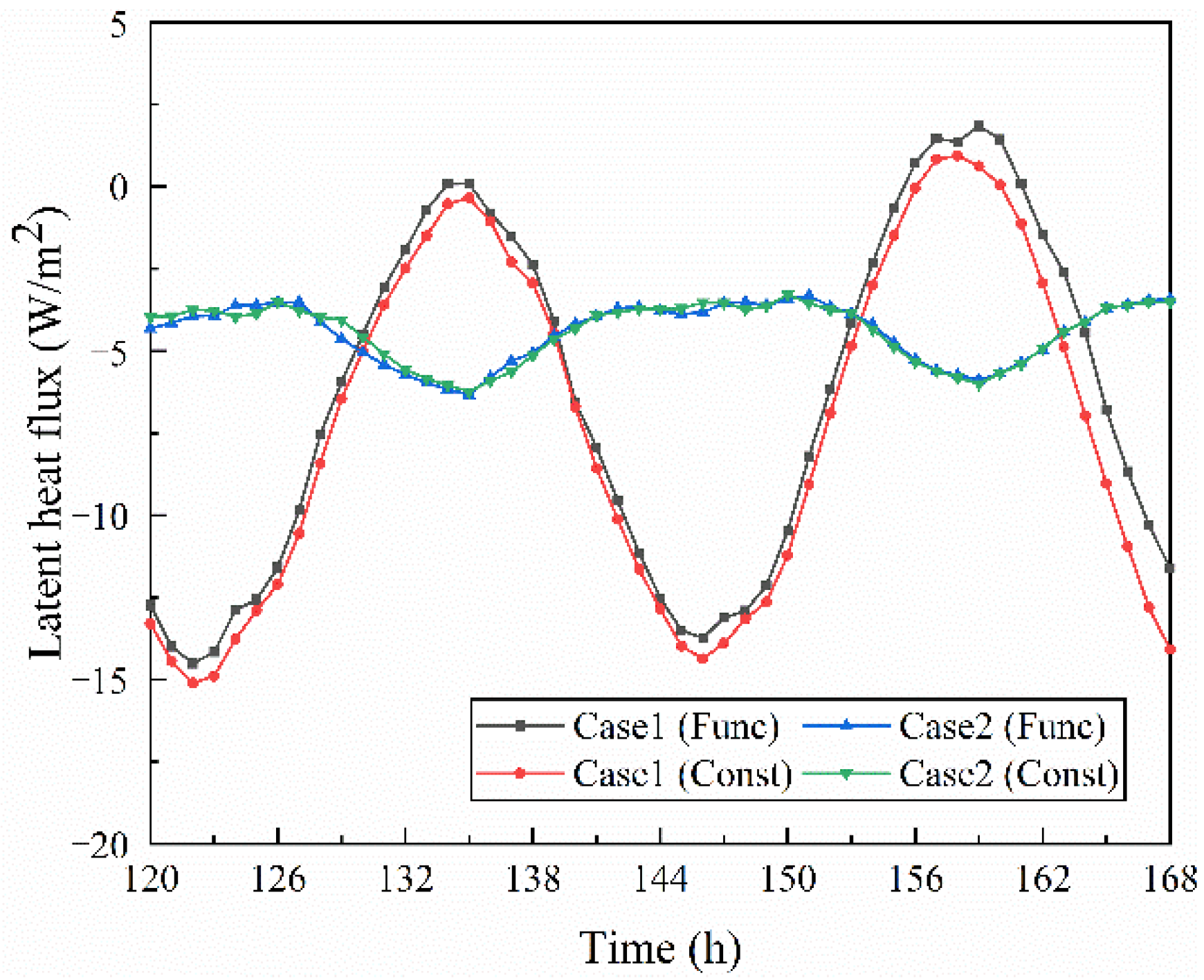



| Compound Name | SiO2 | Al2O3 | Fe2O3 | K2O | MgO | Na2O | TiO2 | CaO | SO3 |
|---|---|---|---|---|---|---|---|---|---|
| Mass fraction (%) | 71.79 | 17.01 | 5.22 | 1.96 | 0.97 | 0.94 | 0.91 | 0.80 | 0.09 |
| Moisture Content (%) | Thermal Conductivity (W/mK) |
|---|---|
| 0 | 0.528 |
| 2 | 0.601 |
| 4 | 0.644 |
| 6 | 0.716 |
| 8 | 0.782 |
| 10 | 0.843 |
| 12 | 0.904 |
| 14 | 0.967 |
| 1 | 2 | 3 | 4 | 5 | 6 | |
|---|---|---|---|---|---|---|
| Saturated salt solution | MgCl2 | K2CO3 | NaBr | NaCl | KCl | K2SO4 |
| (%) | 33.07 ± 0.18 | 43.16 ± 0.33 | 59.14 ± 0.44 | 75.47 ± 0.14 | 84.11 ± 0.29 | 97.59 ± 0.53 |
| Case 1 | Case 2 | |
|---|---|---|
| Outdoor temperature | ||
| Indoor temperature | ||
| Outdoor relative humidity | ||
| Indoor relative humidity |
Publisher’s Note: MDPI stays neutral with regard to jurisdictional claims in published maps and institutional affiliations. |
© 2022 by the authors. Licensee MDPI, Basel, Switzerland. This article is an open access article distributed under the terms and conditions of the Creative Commons Attribution (CC BY) license (https://creativecommons.org/licenses/by/4.0/).
Share and Cite
Tan, J.; Liang, J.; Wan, L.; Jiang, B. Influence of Non-Constant Hygrothermal Parameters on Heat and Moisture Transfer in Rammed Earth Walls. Buildings 2022, 12, 1077. https://doi.org/10.3390/buildings12081077
Tan J, Liang J, Wan L, Jiang B. Influence of Non-Constant Hygrothermal Parameters on Heat and Moisture Transfer in Rammed Earth Walls. Buildings. 2022; 12(8):1077. https://doi.org/10.3390/buildings12081077
Chicago/Turabian StyleTan, Jiaye, Jiahua Liang, Li Wan, and Bin Jiang. 2022. "Influence of Non-Constant Hygrothermal Parameters on Heat and Moisture Transfer in Rammed Earth Walls" Buildings 12, no. 8: 1077. https://doi.org/10.3390/buildings12081077
APA StyleTan, J., Liang, J., Wan, L., & Jiang, B. (2022). Influence of Non-Constant Hygrothermal Parameters on Heat and Moisture Transfer in Rammed Earth Walls. Buildings, 12(8), 1077. https://doi.org/10.3390/buildings12081077






